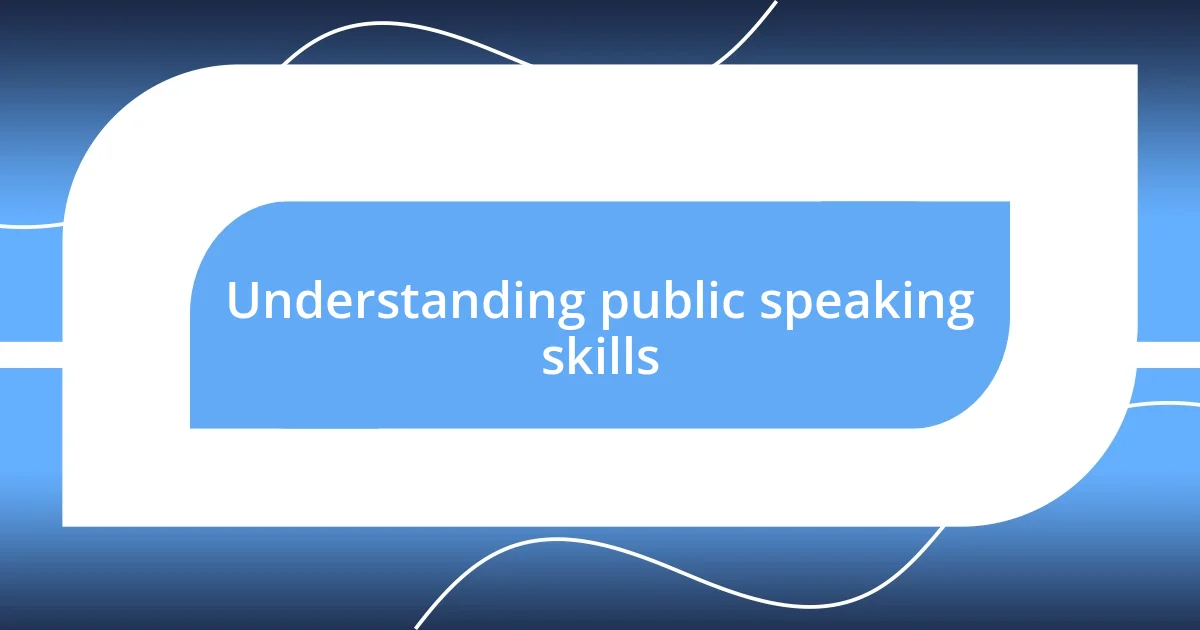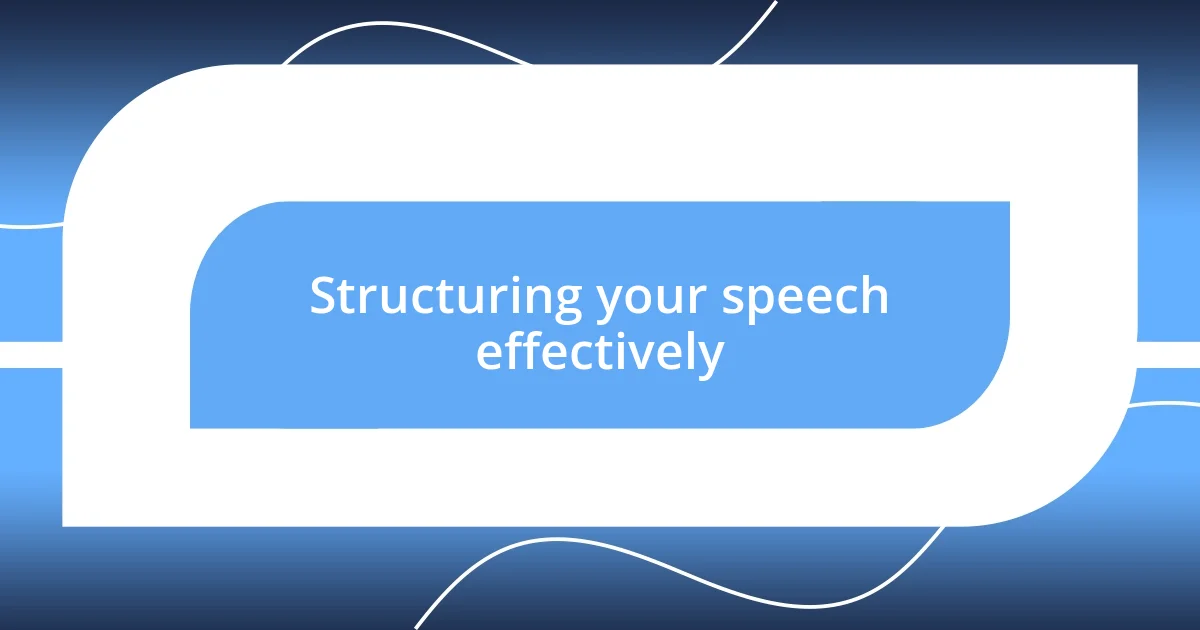Key takeaways:
- Mastering public speaking involves storytelling, body language, and vocal variety to engage the audience emotionally.
- Practice and constructive feedback are essential for building confidence, identifying blind spots, and fostering growth as a speaker.
- Using techniques like deep breathing, visualization, and mental reframing can help manage anxiety and transform challenges into opportunities for connection.

Understanding public speaking skills
Public speaking skills encompass not just what you say but how you say it. I remember the first time I stood in front of an audience; my hands shook, and my heart raced. That visceral reaction made me realize that mastering the craft requires an understanding of the emotional undercurrents at play—both in yourself and in your audience. Have you ever felt a sense of vulnerability when sharing a personal story? That feeling can either connect you deeply to your listeners or send you spiraling into anxiety.
One of the most enlightening moments for me was discovering the power of storytelling. When I began to weave in personal anecdotes, I noticed a shift in the room’s energy. Suddenly, my audience was no longer just spectators; they were engaged participants. Isn’t it fascinating how a well-timed story can create a sense of intimacy? The ability to share experiences that resonate with others is a crucial skill in public speaking.
Effective public speaking also hinges on body language and vocal variety. I once watched a speaker transform a dull topic into an engaging conversation simply by changing their tone and posture. It made me think: Are we even aware of how our non-verbal cues influence our message? I’ve learned that every gesture and inflection can either reinforce or undermine what we say, highlighting the importance of being mindful about our presentation style.

Importance of practice and feedback
When it comes to public speaking, I’ve learned that practice is the backbone of confidence. I remember spending countless evenings rehearsing my speeches in front of a mirror, sometimes stumbling over my words or losing my train of thought. But each practice session brought me closer to mastering my material. It’s not just about repeating lines; it’s about discovering how to express them authentically. This journey taught me that repetition builds familiarity, which in turn, breeds confidence.
Feedback is equally vital. After one of my early presentations, a friend offered constructive criticism that initially stung. However, I chose to view it as invaluable insight rather than a setback. Here’s how feedback has shaped my journey:
- Identifies blind spots: It helps me see things I might overlook.
- Encourages growth: Constructive feedback provides a roadmap for improvement.
- Stimulates confidence: Positive reinforcement boosts my morale and motivates me to keep improving.
By embracing both practice and feedback, I found a pathway not only to becoming a better speaker but also to connecting more deeply with my audience.

Techniques for reducing anxiety
When it comes to managing anxiety before stepping onto the stage, I’ve discovered a few techniques that genuinely make a difference. One strategy that has worked wonders for me is deep breathing. Before I present, I take a few moments to focus on my breath, inhaling deeply through my nose, holding for a few seconds, and exhaling slowly. This practice not only calms my nerves but also helps ground me in the present moment. Have you ever noticed how anxiety tends to escalate when your thoughts race ahead? Deep breathing can serve as a gentle reminder to slow down and regain control.
Another technique I often employ is visualization. I visualize myself confidently delivering my speech, engaging with the audience, and receiving applause at the end. This mental rehearsal, I find, creates a sense of familiarity with the experience that helps alleviate fear. It’s a bit like preparing for a big game—if you can see yourself winning, it becomes a little easier to make that happen. Have you tried visualizing your success? The more vividly I imagine it, the less anxious I feel.
Lastly, I embrace a mindset shift by reframing my thoughts about public speaking. Instead of viewing it as a daunting challenge, I remind myself that it’s an opportunity to connect and share ideas. This perspective has transformed my experience. Instead of feeling isolated in my anxiety, I remind myself that we’re all in this together; the audience is rooting for me, not against me. Honestly, this simple change in thought can turn anxiety into excitement.
| Technique | Description |
|---|---|
| Deep Breathing | Focus on inhaling and exhaling to calm nerves and ground yourself. |
| Visualization | Mentally rehearse delivering your speech successfully to reduce fear. |
| Mental Reframing | Shift perspective from anxiety to opportunity, fostering a connection with your audience. |

Structuring your speech effectively
When structuring a speech, I find that creating a clear roadmap is essential for both myself and my audience. I often begin with a strong hook—something that captures attention right away. For instance, during my last presentation, I started with a surprising statistic that not only piqued interest but also set the stage for my main points. This initial engagement is crucial; it draws listeners in and prepares them for what’s to come. Have you ever noticed how a powerful opening can change the entire tone of a presentation?
I also believe in the ‘rule of three’—organizing my content into three main points. This structure makes my speech more digestible and memorable. While preparing for a recent talk, I divided my message into three clear sections, each supported by personal anecdotes. As I shared stories about my journey, I could see the audience relate to my experiences, which only emphasized the importance of this structure. It’s fascinating how a simple layout can enhance the connection one has with the audience.
Finally, I wrap up with a strong conclusion that reinforces my key messages. I like to leave my listeners with a call to action or a thought-provoking question—something they can ponder long after my speech ends. After delivering a conclusion that encouraged my audience to reflect on their own experiences, I was pleasantly surprised by the engagement that followed. It’s rewarding to know that a well-structured speech can resonate with others and spark meaningful conversations. How do you usually end your speeches to leave a lasting impression?

Engaging your audience actively
Engaging your audience actively is crucial in making your speech not just heard, but felt. I’ve found that asking questions throughout my presentation invites immediate interaction and interest. For example, during a recent talk, I paused to ask, “How many of you have faced a similar challenge?” Watching my audience nod in recognition sparked a shared energy that fueled my confidence. It’s amazing how a simple question can transform a monologue into a dialogue.
I also enjoy incorporating stories that resonate with my listeners. When I share personal experiences, I make a conscious effort to connect my emotions with theirs. I recall a time when I spoke about overcoming a significant obstacle in my career. As I described the feelings of doubt and determination I faced, I could see people lean in, visibly invested in my journey. Storytelling turns abstract concepts into relatable experiences, creating a bond that lingers long after the speech is over. Have you ever felt that connection when someone shared a piece of their life with you?
Lastly, I utilize visual aids to reinforce my message and maintain attention. During one presentation, I used a mix of images and simple charts to illustrate my key points visually. It was delightful to see the audience engage with the visuals, their reactions reflecting understanding and curiosity. This approach not only keeps the audience interested but also caters to different learning styles. How do you ensure your audience stays engaged? I believe balancing interaction, storytelling, and visuals can create a holistic experience that resonates deeply.

Using body language strategically
Using body language strategically can significantly elevate the impact of your speech. I remember one time standing in front of a large audience, my palms a little clammy and my heart racing. As I took deep breaths and consciously opened my arms, I felt the tension easing and saw the audience respond positively to my expanded posture. Isn’t it fascinating how a simple shift in stance can project confidence and make listeners more receptive?
I also pay close attention to my facial expressions. They’re a critical part of communication that often goes unnoticed. During a particularly emotional segment of my last presentation, I leaned in slightly and softened my gaze as I shared a heartfelt story about a mentor who inspired my career. I could sense a shift in the room; people seemed to connect with me on a deeper level. Have you noticed how a genuine smile or a thoughtful frown can evoke an emotional response?
Additionally, I’ve found that using purposeful gestures can emphasize key points and keep the audience engaged. While presenting, I often incorporate hand movements that complement my words. I vividly recall a moment when I was discussing the importance of collaboration. I used my hands to visualize different pieces coming together, and I could see nods of understanding and agreement. Could it be that our bodies speak even louder than our words? Emphasizing points through movement not only captivates attention but also reinforces the message in a memorable way.

Learning from your experiences
When I reflect on my journey in public speaking, it’s clear that my experiences have been my best teachers. I remember stumbling over my words during my first few presentations; it was nerve-wracking. But what I learned was invaluable. Each hiccup pushed me to adapt and improve. Have you ever felt that awkward moment when time seemed to freeze? I began to see those moments not as failures, but as stepping stones toward growth.
One lesson that stands out is the importance of feedback. After a presentation, I made it a habit to seek out constructive criticism from trusted peers. I recall receiving a tip about pacing: “You rush through your best points!” Their insight hit home. Slowing down allowed my audience to absorb my message more fully. It’s incredible how external perspectives can illuminate areas for improvement that we might overlook ourselves, isn’t it?
Additionally, I’ve realized that vulnerability can transform a speech. During a time when I shared my fear of public speaking itself, the audience responded with warmth and understanding. I could nearly feel the shift in the room’s energy. Opening up about personal battles has not only made my presentations more relatable but has also helped me connect on a deeper level with my listeners. Isn’t it empowering to know that our shared vulnerabilities can inspire and unite us? Through these experiences, I’ve come to appreciate that every speech is an opportunity for learning and connection.












